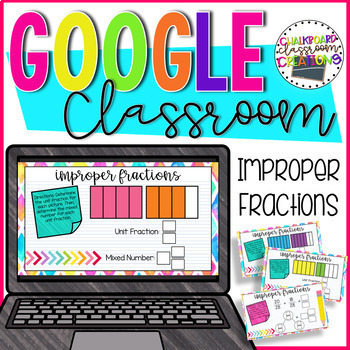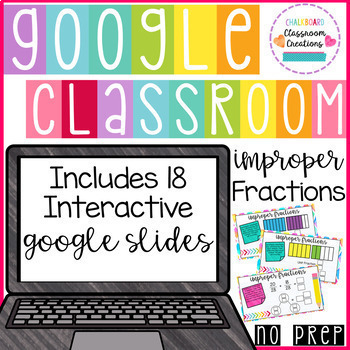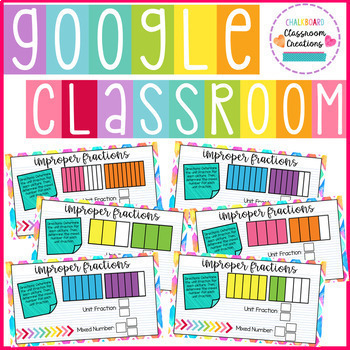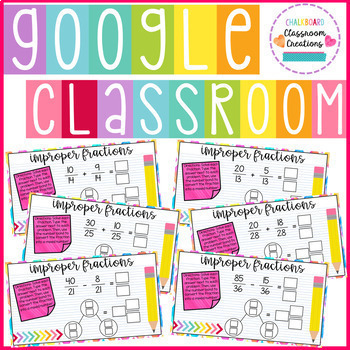4th Grade Improper Fractions to Mixed Numbers for Google Classroom 4.NF.A.1
- Google Drive™ folder

What educators are saying
Also included in
- This 4th Grade Growing Math Bundle for Google Classroom Distance Learning includes 510+ Google Slides that make it easy to implement distance learning with your students. This digital resource can be assigned through Google Classroom or Google Drive.Perfect for 1:1 classrooms. Each Google Slide deckPrice $62.00Original Price $90.00Save $28.00
- This 4th and 5th Grade Fraction Growing Bundle for Google Classroom includes 260+ Google Slides that make it easy to implement technology into the classroom. Perfect for 1:1 classrooms. Each Google Slide deck is aligned to Common Core State Standards.These digital resources can be utilized in the clPrice $36.00Original Price $54.00Save $18.00
Description
This 4th Grade Google Classroom Distance Learning resource includes 18 Google Slides that will enable students to practice converting improper fractions. These digital Task Cards make it easy to implement distance learning with your students. This digital resource can be assigned through Google Classroom or Google Drive. Perfect for 1:1 classrooms. Each Google Slide is aligned to Common Core State Standard 4.NF.A.1.
These digital resources can be utilized in the classroom to help improve student's technology skills. It can be implemented with various operating systems, including Chromebooks, iPads, Laptops, and desktops.
Before you begin using this resource, you will need access to the internet and an individual Google Drive account for you and your students.
Benefits of using digital resources:
✔️Can be implemented in whole group and math centers
✔️An excellent way to assess students' skills.
✔️Great way to prepare students for tests.
✔️Colorful, engaging, and easy to use
✔️Accessible to students anytime
✔️Easy access to students work
✔️Saves paper/copies
Digital Skills Students acquire using Google Slides:
✔️Typing skills
✔️Drag and drop skills
✔️Digital manipulation skills
✔️Scrolling skills
Interested in becoming more knowledgeable about how to integrate technology in your classroom? Click here to follow my blog, where I share step-by-step tutorials on everything Google Classroom. Click on the links to check out these posts from my blog.
⭐ Creating assignments in Google Classroom
⭐ How to create self-grading Google Form Quizzes
⭐ How to share Google Slides with students
⭐ Click HERE to check out my blog post about 3 Ways to Create Google Classroom Math Resources for Distance Learning.
❤️ Visit my sister store at Little Chalkboard Creations for Transitional Kindergarten and Kindergarten Google Classroom resources. ❤️
Save 20% on this digital resource by purchasing it as part of a Google Classroom Bundle:
You may also like these 4th Grade digital resources:
Multiplying using Mental Math for Google Classroom
Place Value Standard Form for Google Classroom
Multiplying using Partial Products for Google Classroom
Place Value Comparing Values for Google Classroom
Multiplication for Google Classroom
Multiplying using an Area Model for Google Classroom
Dividing using Visuals for Google Classroom
Decomposing Fractions for Google Classroom
Equivalent Fractions for Google Classroom
Comparing Fractions for Google Classroom
Adding and Subtracting Like Fractions for Google Classroom
Adding and Subtracting Mixed Numbers for Google Classroom
Improper Fractions for Google Classroom
Simplifying Fractions for Google Classroom
Multiplying Fractions & Whole Numbers for Google Classroom
Area and Perimeter for Google Classroom
Converting Change to Fractions for Google Classroom
Measuring Angles for Google Classroom
Identifying Lines for Google Classroom
Measuring Angles for Google Classroom
Perimeter for Google Classroom
Perimeter for Google Classroom
You may also like these 2nd Grade digital resources:
Multiplication Strategies for Google Classroom
Place Value for Google Classroom
Addition using Place Value for Google Classroom
Counting Money for Google Classroom
Creating Arrays for Google Classroom
Adding and Subtracting for Google Classroom
Place Value for Google Classroom
Place Value Expanded Form for Google Classroom
Telling Time for Google Classroom
Reading Bar Graphs for Google Classroom
Counting Money for Google Classroom
Measuring Lengths for Google Classroom
Connect with Me:
Follow my store for new Google Drive digital activities. I throw frequent sales. Be the first to know by following my store.
Click Here</a> to follow my store.
I value your feedback. Your reviews are greatly appreciated.







